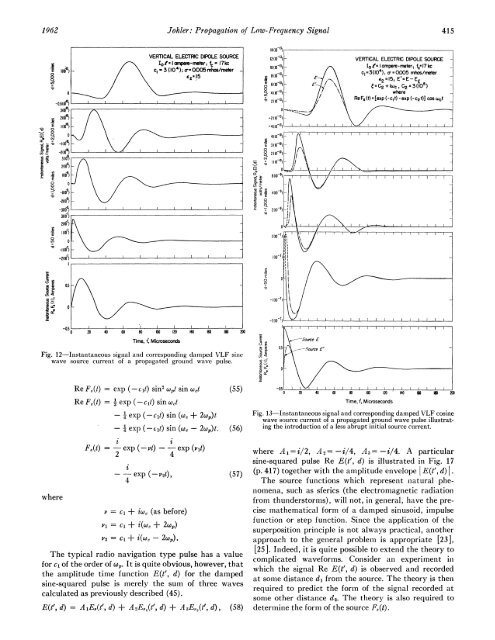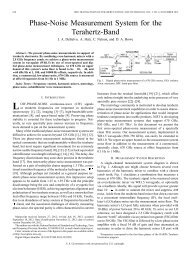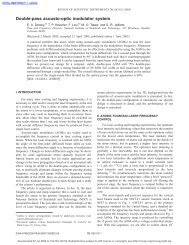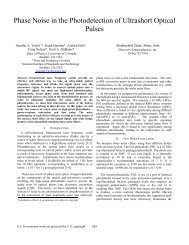Propagation Low-Frequency
Propagation Low-Frequency
Propagation Low-Frequency
Create successful ePaper yourself
Turn your PDF publications into a flip-book with our unique Google optimized e-Paper software.
1962<br />
ll<br />
((I2)I<br />
0<br />
Johler: <strong>Propagation</strong> of <strong>Low</strong>-<strong>Frequency</strong> Signal<br />
14(0-13)<br />
12 (10-13)<br />
to 0(i0-')<br />
1 8 (10 13)<br />
E 6 (10 13)<br />
0<br />
< 4(1003)<br />
-n iti" 12~ I]<br />
x 2(10 13)<br />
3(0) 0KO<br />
20<br />
E */\) - 0-13) II<br />
- 10<br />
0<br />
4(109° } 2(10- °<br />
tW 2(109) ~2(1°-!3 f\<br />
-(20-9) -((010)<br />
-E E 20Lo OO-p °<br />
0 0n<br />
0~~~~~~~~~~~~~~~~~~~~~~~~~~~~~~~~~~~~~~~~~~~~~~~~~~~~0<br />
__9_<br />
A? E<br />
0<br />
to<br />
0.5<br />
0<br />
I<br />
60 80 100 120 40 160 10 200<br />
Time, t' Microseconds<br />
Fig. 12-IInstantaneous signal and correspondinig damped VLF sine<br />
wave source current of a propagated ground wave pulse.<br />
where<br />
-nhS<br />
0 20 40<br />
Re F0(t) = exp (-cit) sin2 o.,t sin w,t<br />
Re F,(t) = 1 exp (- cit) sincot<br />
-_ exp (-c1t) sin (w, + 2cow)t<br />
-4 exp (-cit) sin (wc - 2co)t.<br />
Fs(t) = - exp (-Pt)- -<br />
i i<br />
2 4<br />
exp (vpt)<br />
(55)<br />
(56)<br />
--exp (-V2t), (57)<br />
4<br />
= cl + iwc (as before)<br />
Vo = C1 + i(w, + 2wo)<br />
P2 =<br />
C1<br />
.I<br />
+ i(cw,- 2p).<br />
VERTICAL ELECTRIC DIPOLE SOURCE<br />
I I l-I aTr e-meter; fc - 17kc<br />
cl - 3(104);cr- 0,005 mhos/meter -<br />
P.215<br />
The typical radio navigation type pulse has a value<br />
for cl of the order of cop. It is quite obvious, however, that<br />
the amplitude time function E(t', d) for the damped<br />
sine-squared pulse is merely the sum of three waves<br />
calculated as previously described (45).<br />
E(t', d) = AI E,(t', d) + A2Ep,(t', d) + A 3E,,(t', d), (58)<br />
c<br />
0?<br />
0 1._<br />
, Lu<br />
n; E<br />
us -r<br />
w ,r<br />
a 4><br />
cE x<br />
R<br />
F-..<br />
7.<br />
.I<br />
V.Vi AAI<br />
20 0 40 60 s0 (00 120 140 0 U10 200<br />
Time, t. Microseconds<br />
415<br />
VERTICAL ELECTRIC DIPOLE SOURCE -<br />
10o = ampere-meter; fc- 17 kc<br />
cl=3(104). a- = 0005 mhos/meter<br />
E- /~. \ s2=15; E'=E-Ec<br />
E-6C,<br />
-\t=C2+iwc, C2=3(O3 -<br />
where-<br />
Re Fs (t) =[exp (-c1t) - exp (-c21)] cos wCt<br />
E<br />
----.qource E'<br />
Fig. 13-Instantaneous signal and corresponding damped VLF cosine<br />
wave source current of a propagated ground wave pulse illustrating<br />
the introduction of a less abrupt initial source current.<br />
where A i = i/2, A2 =-i/4, A3 =-i/4. A particular<br />
sine-squared pulse Re E(t', d) is illustrated in Fig. 17<br />
(p. 417) together with the amplitude envelope E(t', d) |.<br />
The source functions which represent natural phenomena,<br />
such as sferics (the electromagnetic radiation<br />
from thunderstorms), will not, in general, have the precise<br />
mathematical form of a damped sinusoid, impulse<br />
function or step function. Since the application of the<br />
superposition principle is not always practical, another<br />
approach to the general problem is appropriate [23],<br />
[25]. Indeed, it is quite possible to extend the theory to<br />
complicated waveforms. Consider an experiment in<br />
which the signal Re E(t', d) is observed and recorded<br />
at some distance d, from the source. The theory is then<br />
required to predict the form of the signal recorded at<br />
some other distance d2. The theory is also required to<br />
determine the form of the source F8(t).<br />
II





